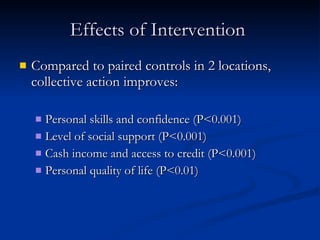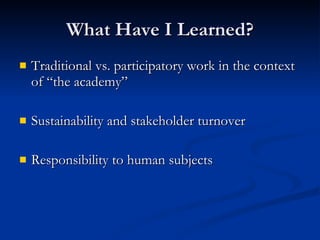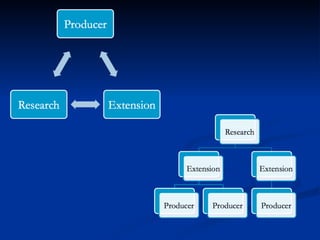The Quest for Impact: The Transformation of Research from a Traditional to a Participatory Format in Southern Ethiopia
- 1. The Quest for Impact: From Traditional to Participatory Research in Ethiopia Layne Coppock PARIMA Project, GL-CRSP Closing Conference Naivasha, Kenya, 2009
- 2. Roadmap Background Example from Southern Ethiopia What Have I Learned? Academics/scholarship Sustainability Role of Livestock CRSP
- 6. Impact Assumptions Proper problem diagnosis Lack of other systemic constraints Effectiveness of extension
- 11. Researched Topics, 1985-99 Pastoral livelihoods (trends, diversification prospects) Descriptive rangeland ecology Trials: Options to improve calf growth Trials: Options to improve forages Trials: Options to improve milk processing
- 14. Does any of this matter?
- 15. Shift in Approach, 2000-09 PRA (joint problem diagnosis) Peer-to-peer learning/Cross-border diffusion Action Research (monitoring/problem solving) Structured survey (groups vs. non-groups)
- 17. PRA Results, 2000 Results from several Boran communities were remarkably similar Lack of food and water seen as the primary problem Locally sustainable solutions focused on education, diversified livelihoods
- 21. Data from Kenya Groups 16 group leaders interviewed Avg group age = 10 years Avg charter members = 24 (no men) Avg illiteracy = 85% Half of groups formed spontaneously Detailed constitutions, by-laws (memorized) Savings; livelihood diversification; publ. services High success rates; internal/external challenges
- 25. Group Formation Back in Ethiopia 60 collective-action groups quickly formed between 2001 to 2003 2,167 charter members; 76% women Capacity building short-courses (including micro-finance) were implemented Action research added as a monitoring tool
- 26. Livestock Marketing Groups wanted stronger links to markets PARIMA used participatory processes to help create a new value chain from pastoral producers to livestock exporters in Addis Ababa This coincided with favorable changes in markets and institutions in Ethiopia
- 28. Group Micro-finance Statistics (June 2008) 60 groups, 2001-2008 (not one has failed) Savings mobilized = $92,735 Number of micro-loans = 5,368 Repayment rate = 96% Volume of loan value = $647,666 Loan interest generated = $29,729 Profits from small business = $25,614* Grew to 2,300 group members; over 13,800 direct beneficiaries
- 29. Small Ruminant Market Supply, 2003-05 11 groups monitored, 289 members total Average capitalization of US $3,136 Average head traded per group 2,330 Average profit: US $333 to US $1,111
- 32. Innovation System: Stakeholders International members: 3 Regional members: 12 Local members: 31
- 33. Capacity-Building Cost Estimation Selective inputs for 13,800 beneficiaries PRAs/CAPs = $0.52 (4% of population) Short courses = $4.03 (3%...) Tours = $4.63 (9%...) NF Educ = $0.99 (16%...) Seed loans = $9.96 (17%...) Mon & Eval = $14.16 Total = $34.29 over 3 years
- 34. Effects of Intervention Compared to paired controls in 2 locations, collective action improves: Personal skills and confidence (P<0.001) Level of social support (P<0.001) Cash income and access to credit (P<0.001) Personal quality of life (P<0.01)
- 35. What Have I Learned? Traditional vs. participatory work in the context of “the academy” Sustainability and stakeholder turnover Responsibility to human subjects
- 36. Participation Checklist: Benefits Costs Local impacts Transaction efforts Empirical evidence for More time and money interventions Harder to generalize Satisfaction from results, publish? observing research application Risk of “losing control”
- 38. Emerging Voices “Research for development” “Participation, problem-solving, sustainability science” “Integration and implementation science” “Innovation systems, new forms of knowledge” “Post-normal science”
- 39. Scholarship Assessed (Glassick et al. 1997) Scholarship transition beyond “discovery” to include verifiable links to integration, application, teaching… Is higher ed a private benefit to individuals, or an investment in a collective public good? What scholarship “matters,” and how do scholars work? Need for stronger societal engagement Scholarship ideals: integrity, perseverance, courage
- 41. “First, he wants to know where you will publish”
- 42. Hans Jahnke (1982): “building human capacity is the main way to achieve development impact on marginal lands…”
- 43. Role for Livestock CRSP? Emphasize: Discovery, integration, application Authentic partnerships, sustainability Longer-term funding horizons Supporting “global institutional memory”
- 44. This research was made possible through support provided to the Global Livestock Collaborative Research Support Program by the United States Agency for International Development under terms of Grant No. PCE-G-00-98-00036-00 and by contributions of participating institutions.












































